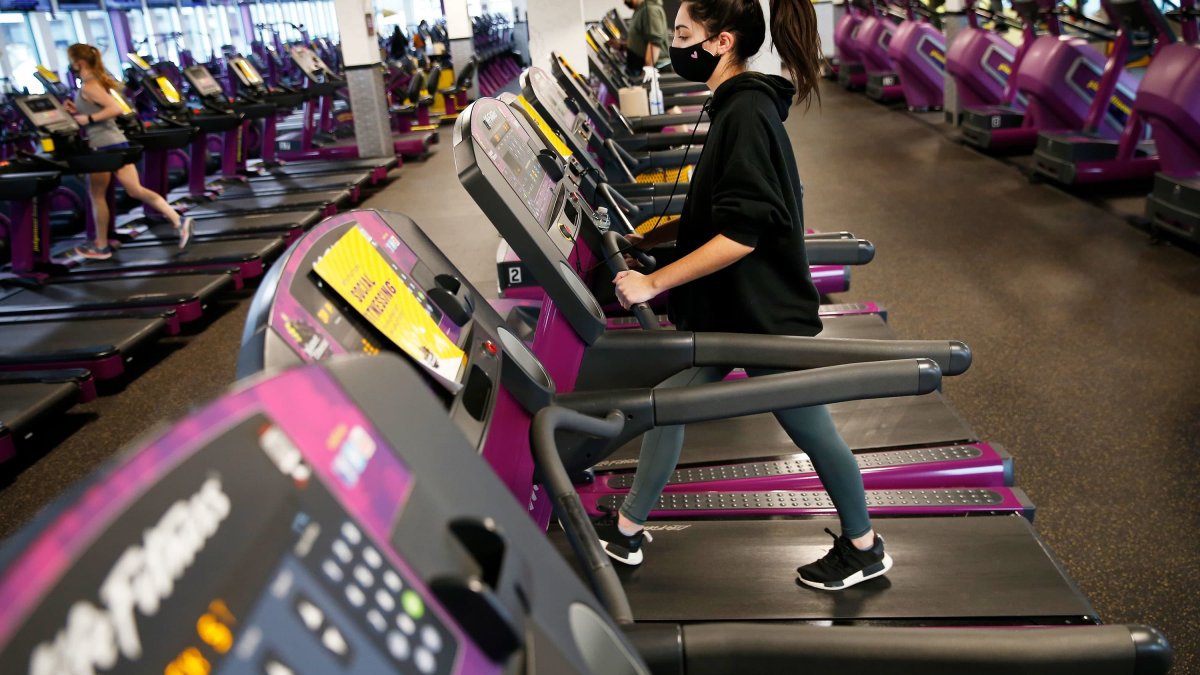Fitness
Importance of Personalized Treatment and Exercise Strategies for Metastatic Breast Cancer – News18

For those diagnosed with cancer, advancements in medical technology and treatment modalities offer hope and healing.
As the landscape of metastatic breast cancer management continues to evolve, the integration of exercise into comprehensive care strategies hold immense promise
In the dimly lit gym, amidst the clinks of weights and the rhythm of treadmills, Anisha finds solace. Diagnosed with metastatic breast cancer three years ago, her journey has been a rollercoaster of emotions and physical challenges. In the quiet moments between conversations with her doctor, discussing treatment options and strategies to enhance her quality of life, Anisha discovered a haven in the act of exercise. For Anisha, sweating it out at the gym is not just about physical fitness; it’s her sanctuary, a place where she finds mental fortitude and resilience to combat the daunting reality of living with metastatic breast cancer.
Anisha’s story echoes the growing body of research highlighting the profound impact of exercise may have on the quality of life for individuals being treated for metastatic breast cancer. Staying active complements metastatic breast cancer treatments by bolstering physical strength, reducing fatigue, and improving mood. Along with the traditional realms of treatment, exercise is emerging as an ally, offering a holistic approach to managing the physical and psychological toll of the disease. However, it’s important to curate your exercise regime in consultation with your oncologist.
Importance of Embracing Holistic Care
In the multifaceted journey of metastatic breast cancer, embracing a holistic approach is paramount. Dr. Raja T, Director, Medical Oncology, Apollo Hospitals, Chennai says, “A crucial aspect of providing comprehensive care to metastatic breast cancer patients is to encourage open communication between the patients and their healthcare providers. Such conversations help in establishing trust, promote partnership, and facilitate informed decision-making. Besides, the focus of treatment should shift towards advanced therapies that cater to the individual patient’s needs and enhance their quality of life. This approach marks the beginning of a new era in personalized care for metastatic breast cancer patients. In addition to clinical treatment, lifestyle factors such as exercise, diet, nutrition, and physical activity play an essential role in improving treatment outcomes and the overall well-being of the patient. By integrating these elements into the treatment plan, patients can navigate their journey with resilience, feel empowered, and commit to a holistic approach to care.”
How Staying Active Can Complement your Metastatic Breast Cancer Treatment
Incorporating regular physical activity into metastatic breast cancer treatment plans can provide a myriad of benefits. Some recent studies have shown that regular exercise can help common symptoms such as fatigue, pain, and anxiety associated with metastatic breast cancer. Additionally evidential support has shown that regular exercise also helps patients in improving sleep quality and overall functional status while going through treatment. The preferable-effect study, a randomized, prospective trial conducted in five European countries plus Australia, showed that participating in a supervised, moderate- and high-intensity exercise program for 9 months had a positive effect on cancer-related fatigue and quality of life in patients with metastatic breast cancer.
Moreover, exercise helps with the psychological distress often associated with a cancer diagnosis. By releasing endorphins and reducing stress hormones, physical activity fosters a sense of empowerment and resilience. This positive mindset and enhanced emotional well-being can empower individuals to take a more engaged approach to their overall care plan.
Furthermore, the findings underscored the significance of a symbiotic relationship between personalized treatment plans and tailored exercise regimens, in consultation with your oncologist. From aerobic exercises to strength training and mind-body practices such as yoga and meditation, the key lies in finding activities that resonate with each individual, fostering a sustainable and enjoyable approach to fitness.
As the landscape of metastatic breast cancer management continues to evolve, the integration of exercise into comprehensive care strategies hold immense promise.
Anisha’s journey exemplifies the transformative power of exercise, illuminating a path towards resilience, strength, and inner peace. By embracing a holistic approach that includes innovative treatment options and personalized fitness regimens, women diagnosed with metastatic breast cancer can maintain active and fulfilling lives.

Fitness
Want to increase your stamina? Work on your cardiorespiratory fitness and endurance!

Cardiorespiratory fitness refers to how well your body does while performing a physical task. A healthy diet, weight control and interval training are great ways to improve this.
An increase in stamina, low chances of heart disease and control over high blood pressure are all benefits of cardiorespiratory fitness. Cardiorespiratory fitness, also known as cardiorespiratory endurance, cardiovascular fitness, and cardiovascular endurance, improves oxygen levels in the lungs and heart when we are doing anything that involves physical exertion.
Cardiorespiratory fitness refers to how well your body can perform when you are exercising. If your cardiorespiratory fitness is on point, you can endure long, physical exercise without getting tired. Read on to learn more about cardiorespiratory fitness, the exercises that can help you improve it, as well as the risks involved.
What is cardiorespiratory fitness?
Cardiorespiratory fitness (CRF) refers to the ability of the cardiovascular and respiratory systems to deliver oxygen during prolonged physical activities. “It is an important sign for overall health and heart function,” explains cardiologist Dr Chirag D.
According to research published in Nutrition in the Prevention and Treatment of Abdominal Obesity, cardiorespiratory fitness can be determined by gender, age and genetics, as well as, the relationship between your health and physical activity. Strong CRF allows you to perform daily activities with more ease, reducing fatigue during tasks like climbing stairs or carrying groceries. It also helps you recover faster from exercise, allowing you to get back to your workout routine sooner.
What are the various endurance tests for cardiorespiratory fitness?
Your cardiorespiratory fitness can be measured through some tests.
Also Read

is when a patient is hooked on to electrodes to measure his heart function while doing an exercise. Image courtesy: Freepik
1. VO2 Max Test
This test measures the maximal uptake of oxygen in a high-intensity exercise. In this exercise, you get on a treadmill or a bike and increase your intensity every few minutes, until you are exhausted. This method is touted to be the most accurate one, states this research, published by the University of Virginia.
2. 6-Minute Walk Test
This test evaluates sub-maximally distance covered within six minutes. This test is low risk and is useful in assessing adults who have love cardiorespiratory fitness, states this study, published in Pulmonology.
3. Treadmill Stress Test
This test monitors heart rate during increasing intensity levels on a treadmill. This test is usually done in a lab, where electrodes are put on the patient’s chest, and these are then connected to an ECG machine. This makes a record of all heart activity, including blood pressure and heart rate, states this study, published by the National Institute of Health.
What are the causes of low cardiorespiratory fitness?
Various causes are associated with low respiratory fitness levels. Some of these are as follows:
- Sedentary lifestyle: No regular exercise and sedentary desk jobs can lead to cardiorespiratory fitness levels dropping. No exercise often leads to fatty material in your arteries. This can cause serious problems, including a heart attack. Exercise is beneficial for cardiovascular health, states this study, published in Frontiers in Cardiovascular Medicine.
- Chronic diseases: Illnesses like heart attack, diabetic condition, and lung problems can also lead to a drop in cardiorespiratory fitness. This disease can also cause pain and fatigue.
- Obesity: The burden of excessive body weight on the heart and lungs can lower cardiorespiratory fitness levels. It may also lead to cardiovascular diseases and needs to be worked on at once, reports a study, published in the Journal of Obesity.
- Aging: Gradual deterioration of body strength and muscle mass over time. A study, published in the Archives of Internal Medicine, states that cardiorespiratory fitness levels decrease with age.
How can you improve your cardiorespiratory fitness?
There are various ways to work on your cardiorespiratory fitness levels. Here are a few ideas that you can try out.
Select Topics of your interest and let us customize your feed.
PERSONALISE NOW
1. Regular aerobic exercise
Regular exercise such as walking, running, and cycling improves the performance of both the heart and lungs. A study, published in Research Quarterly for Exercise and Sport, states that adults should do 150 minutes of moderate-intensity or 60 minutes of vigorous-intensity physical activity per week, as recommended by the American College of Sports Medicine (ACSM) and the American Heart Association (AHA).
2. Interval training
Endurance can be enhanced through fluctuating intensities between highs and lows. High-intensity interval training is a form of exercise where you have short periods of intense and explosive movements, followed by low-intensity exercise or even rest. This helps control obesity and increase cardiorespiratory fitness levels, states this study, published in Frontiers in Public Health.
3. Healthy diet
Nutrient-rich foods support overall physical health and energy levels. A study, published in Nutrients, observed the impact of a healthy diet on a group of Korean adults from 19-64 years. The VO2 Max test was used to determine the cardiorespiratory fitness levels. It was seen that adults, in the age group of 19-34 years, reported high CRF levels.
4. Consistency
Regular, sustained effort is crucial for long-term improvements. Make sure that you continue to do the above-mentioned things regularly to see a change.

Cardiorespiratory activities
You can try some cardio-respiratory activities that help elevate your breathing and heart rate for an extended period of time, suggests fitness expert and Fit India Ambassador Wanitha Ashok.
- Brisk walking
- Running
- Jogging
- Cycling
- Swimming
- Aerobics
- Dance
- Zumba
- Jumping rope
- Stair climbing
- Treadmill
- Stationary cycling
- Cross trainer
- Circuit training
- High-intensity interval training (HIIT)
- Kickboxing
What to keep in mind while doing CRF exercises?
Make sure to keep these things in mind when you practice cardiorespiratory fitness:
- One should start slow and gradually build the workout in terms of duration and intensity.
- You should not push yourself and listen to your body.
- Hydration before, during and after the cardio respiratory exercises is advised to replace the list water in the form of sweat and to prevent giddiness and nausea.
- It’s not advisable to do cardio respiratory exercises in the hot Sun, the best time to workout is early morning or evenings. In cold temperatures it’s advisable to be dressed in layers.
What are the risk factors related to cardiorespiratory fitness?
Low cardiorespiratory fitness, linked to an inactive lifestyle, weakens your body’s ability to use oxygen during exercise. Age, genetics, and certain medical conditions can also contribute. Additionally, high lipid values, high blood pressure, higher heart rates, higher waist circumference and higher body fat percentages can affect cardiorespiratory fitness levels, states this study, published in Scientific Reports.
Regular physical activity is key to improving your CRF. Even small increases in activity can significantly benefit your heart, lungs, and overall health.
Fitness
Does the perfect workout really exist?

The first time Olympia Cure tried a pair of rebound boots—a ski-boot-like shoe with a flexible, plastic oval attached to the bottom—she “felt like a kid on a trampoline.”
Soon after, Cure, a fitness enthusiast and part-time roller skating instructor in Chicago, launched Chainless Movements, a group rebound class that resembles step aerobics on space-age stilts. Since December, she says, she’s lost five pounds, and her endurance has increased.
A 2019 ClassPass survey found that participation in non-traditional fitness classes, such as trampoline workouts, bungee fitness, and dance cardio, increased by 82 percent compared to the previous year.
But to some, classes like Cure’s—plus a swath of other trendy group workouts like bungee fitness, trampoline jumping, and drumstick routines—have become the subject of ridicule. On sites like YouTube and TikTok, millions have posted videos with the running joke, Middle Aged Women Doing Anything But Working Out.
Traditionalists sometimes view unconventional workouts as fads lacking scientific backing, while proponents argue that these new methods can enhance motivation and make exercise more accessible and enjoyable.
Yet, with a glut of information and limited time, choosing the best way to work out can be daunting. Research alone suggests one should forego the flying bungees. But what about exercisers disinclined to hit a weight bench or intimidated by CrossFit? Is there any such thing as a perfect workout? Here’s what the experts say.
It’s all about exercise “buckets”
Though there are few large, high-quality studies on trampolining and other fitness trends, the studies that do exist suggest it improves balance, cardiovascular fitness, and pelvic floor musculature. It is also gentler on the joints and often has a lower perceived level of exertion since it is generally more fun.
However, the value of weightlifting and high-intensity cardio for weight loss has been around for years. A recent study found that lifting reduced women’s cardiovascular mortality by a whopping 30 percent.
(Lifting heavy weights is for middle-aged women too.)
But Mike Roussell, author of Strength: The Field Manual and a nutrition expert, says it’s more about ticking certain fitness boxes than one particular workout.
“You need cardiovascular training, and you need resistance training, and having both is the ultimate fitness résumè,” he says.
In the cardio “bucket,” Roussell says, aim for low-intensity cardio—low enough to hold a conversation while you move—and bursts of high intensity. Low-intensity cardio strengthens parts of the heart, lowering blood pressure and resting heart rate. In high-intensity cardio, the heart pumps more intensively and forces the body to use different kinds of fuel, called metabolic flexibility, which boosts longevity and disease prevention.
Then there’s the resistance “bucket.” Building strength and power contribute to longevity, says Roussell, partly because lean body mass helps prevent falls and fractures later in life and makes it easier to maintain muscle later. “It’s just like your retirement savings,” he says. “You’re going to spend it, but at least you have it there.”
(Here’s what lifting weights does to your body—and your mind.)
As if that weren’t enough to make the barbell-averse reconsider, resistance training has also contributed to brain health.
“It’s like physical Sudoku,” says Stacy Sims, an exercise physiologist with expertise in women’s athletics. “Wordle and Sudoku are good for neural pathways. But you could do resistance training and get a bigger bang for your buck because you get better muscles, better metabolic control, and brain health.”
Sims recommends thinking of resistance training in terms of three movement planes: quad-dominant/glute-dominant (think squats), push-pull upper body (bench overhead press), and posterior work (deadlifts and Cossack squats).
“Then you’re looking at the functionality of the different planes of movement and the different exercises that you can put in there, depending on what people are doing in their lives,” she adds.
Evolution of fitness trends
This isn’t the first time a trendy workout has faced criticism. In the early 20th century, calisthenics and gymnastics were sometimes considered too basic and rigid, unsuitable for all populations. The 1950s and 1960s brought home workouts into the spotlight, but programs like Jack LaLanne’s were criticized for their simplistic approach and lack of personalized guidance, potentially leading to injuries.
The aerobics boom of the 1970s and 1980s, popularized by Jane Fonda, faced criticism for its high-impact nature, which could cause joint injuries. At the same time, bodybuilding was scrutinized for promoting unrealistic body images and the use of steroids.
(The exercise phenomenon born in a prisoner-of-war camp.)
In the 1990s, step aerobics and spinning were noted for the risk of repetitive strain injuries, and yoga and Pilates were sometimes dismissed as too gentle or ineffective for weight loss. The 2000s saw the rise of functional fitness with CrossFit, which faced criticism for high injury rates and intense workouts, as did boot camps and HIIT for being potentially dangerous for beginners.
From the 2010s to the present, boutique fitness studios have sometimes been seen as elitist due to their high costs, while digital and at-home workouts raised concerns about a lack of personalized guidance.
Finding balance
For both Sims and Rousell, the best workouts are those that take real life into account. Roussell calls it “the gray area”—where fitness and nutrition goals meet things like business travel, parenting, and parties.
Instead, he says, the secret to success is embracing the nuances and realities of one’s real-life demands. Start with what you enjoy, and add whatever exercise components you might be missing.
(Walking is the sixth vital sign. Here’s how to do it right.)
“We have to look at that motivation component,” says Sims. “If someone likes to walk, I tell them to put a weighted backpack on because that’s going to give you extra load that you have to push against. You’re still doing what you love, but you are getting some resistance training component to it.”
For Olympia Cure’s rebound students in Chicago, the motivation factor has opened the door to regular fitness.
“A lot of the residents said they don’t have affordable fitness options around us that would trick the mind,” she says. “They want to do something that makes them think, ‘I’m not really exercising. I’m just having fun.’”
Fitness
Planning to work on that 'summer body'? Planet Fitness will offer free classes. Here's how to register

Planet Fitness is giving teenagers an opportunity to stay fit while classes are out for the summer.
For the fourth year in a row, the fitness chain is bringing back its High School Summer Pass Program to help high schoolers “to promote youth health and wellness and improve the physical and mental health of millions of teens,” the company said on its website.
Under the program, teenagers 14 to 19 years old will be able to exercise at any of more than 2,400 Planet Fitness locations from June 1 throughout Aug. 31. To register, all teens have to do is visit the Summer Pass page on the Planet Fitness website and fill out the requested information. Anyone under 18 years old must register alongside a parent or guardian – whether they choose to do so online or in-person.
Summer Pass participants will have access to free workouts designed specifically for high schoolers by downloading the Planet Fitness app.
-

 Politics1 week ago
Politics1 week agoVulnerable Dem incumbents move to the center in key swing states as Biden panders to far-left base
-

 World1 week ago
World1 week ago‘Monstrous crime’: World reacts to attack on Slovakia’s prime minister
-

 News1 week ago
News1 week agoHow a migrant aid group got caught up in a right-wing social media thread : Consider This from NPR
-

 Politics1 week ago
Politics1 week agoSouthern border migrant encounters decrease slightly but gotaways still surge under Biden
-

 Politics1 week ago
Politics1 week agoDem newcomer aims for history with primary win over wealthy controversial congressman
-

 World1 week ago
World1 week agoSlovakia PM Robert Fico in ‘very serious’ condition after being shot
-

 World1 week ago
World1 week agoCanadian Nobel-winning author Alice Munro dies aged 92
-

 Movie Reviews1 week ago
Movie Reviews1 week agoIs Coppola’s $120M ‘Megalopolis’ ‘bafflingly shallow’ or ‘remarkably sincere’? Critics can’t tell




















